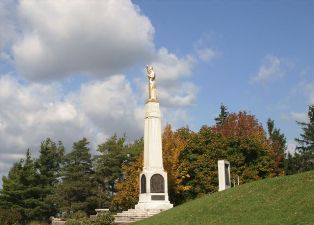Difference between revisions of "Cumorah"
| Line 8: | Line 8: | ||
Mormon, who was a prophet and historian as well as a general, was also the keeper of sacred records. Knowing that the battle at Cumorah would be the Nephites last stand, he hid up most of the sacred records in the hill Cumorah so that their enemies would not find and destroy them. The remainder of the records he entrusted to his son Moroni. | Mormon, who was a prophet and historian as well as a general, was also the keeper of sacred records. Knowing that the battle at Cumorah would be the Nephites last stand, he hid up most of the sacred records in the hill Cumorah so that their enemies would not find and destroy them. The remainder of the records he entrusted to his son Moroni. | ||
| − | Cumorah is also the likely location as the gathering place of the [[Jaredite|Jaredites]] army of [[Coriantumr]] prior to the final battle of the | + | Cumorah is also the likely location as the gathering place of the [[Jaredite|Jaredites]] army of [[Coriantumr]] prior to the final battle of the Jaredites.[http://scriptures.lds.org/en/ether/15/10-15] |
Whether the ancient hill Cumorah and the modern Hill Cumorah are one and the same is of little consequence. Moroni may well have named the hill in modern-day New York Cumorah because of his connections with the other hill. | Whether the ancient hill Cumorah and the modern Hill Cumorah are one and the same is of little consequence. Moroni may well have named the hill in modern-day New York Cumorah because of his connections with the other hill. | ||
Revision as of 18:13, 24 December 2006
Cumorah, more commonly known among Mormons as the Hill Cumorah, is the name given to a hill four miles south of Palmyra, New York. It was in this hill, in roughly the year A.D. 421, that the prophet/historian Moroni deposited a record, engraved upon golden plates, he and his father Mormon had made. Fourteen hundred years later in 1827, that same Moroni directed young Joseph Smith to retrieve the record from the Hill Cumorah. Joseph did as directed and translated the plates into the Book of Mormon.In addition to being a storehouse to the sacred record, the Hill Cumorah was somewhat of a school for young Joseph. During the years between Moroni's first visit to the prophet in 1823 and the time Joseph was allowed to take the plates in 1827, Joseph visited Cumorah. Each year, Moroni would meet Joseph and give him further knowledge and instruction.
Cumorah in the Book of Mormon
In the Book of Mormon, Cumorah was the name of a land and hill where the final battles of that book were fought. In A.D. 384 General Mormon (after whom the Book of Mormon was named) gathered all his people (known as the Nephites) to the land Cumorah. There, his armies and the armies of the enemy (known as Lamanites) clashed in war. At that tremendous battle, tens of thousands of Mormon's people were slain. After the battle, Mormon records that the enemy "had gone through and hewn down all my people save it were twenty and four of us, (among whom was my son Moroni)" (Mormon 6:11). From atop Cumorah, Mormon looked out over his fallen people and mourned their loss.
Mormon, who was a prophet and historian as well as a general, was also the keeper of sacred records. Knowing that the battle at Cumorah would be the Nephites last stand, he hid up most of the sacred records in the hill Cumorah so that their enemies would not find and destroy them. The remainder of the records he entrusted to his son Moroni.
Cumorah is also the likely location as the gathering place of the Jaredites army of Coriantumr prior to the final battle of the Jaredites.[1]
Whether the ancient hill Cumorah and the modern Hill Cumorah are one and the same is of little consequence. Moroni may well have named the hill in modern-day New York Cumorah because of his connections with the other hill.
The Hill Cumorah Today
In 1928 The Church of Jesus Christ of Latter-day Saints, or Mormon Church, purchased the Hill Cumorah and in 1935 erected a monument commemorating the visit of the Angel Moroni. The Church later built a visitors' center at Cumorah's base. The visitors' center offers information not only about the Hill Cumorah, but about numerous other Mormon Church history sites in the area.
Nearly every summer since 1935 the Mormon Church has sponsored a free pageant at Cumorah entitled America's Witness for Christ. The pageant, which runs in July and has a cast of 650, is commonly referred to as the Hill Cumorah Pageant and draws around 100,000 visitors a year. The current pageant was written by renowned Mormon author Orson Scott Card based upon the Bible and the Book of Mormon. The pageant consists of 10 short stories:
- The Prophet Lehi
- The Visions of Christ
- The Building of a Ship
- The Voyage to Ancient America
- The Burning of Abinadi
- The Ministry of Alma
- The Prophecy: A Day, a Night and a Day
- The Resurrected Christ Appears to Ancient Americans
- The Written Word: A Golden Message
- The Restoration of Christ's Kingdom
